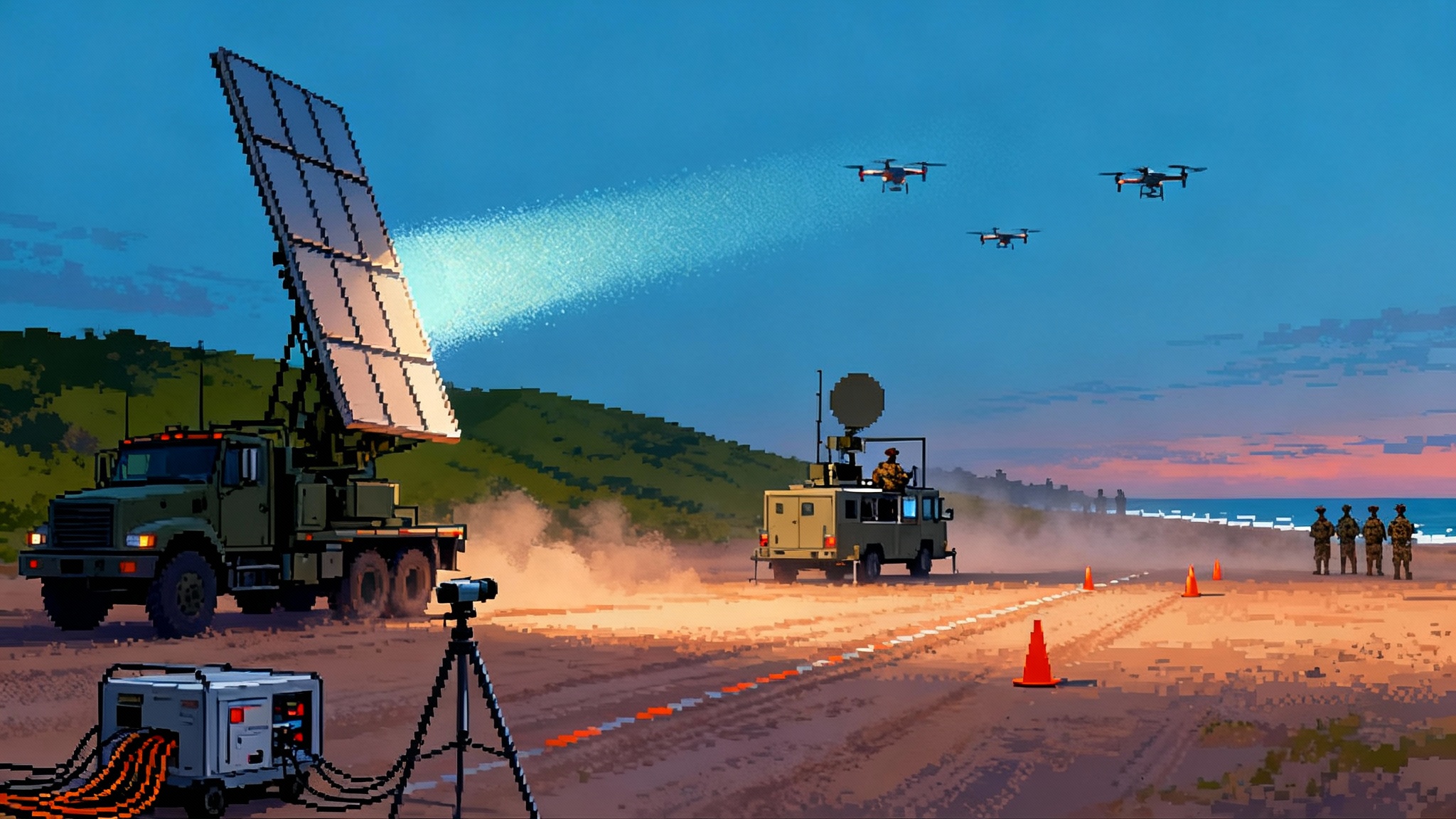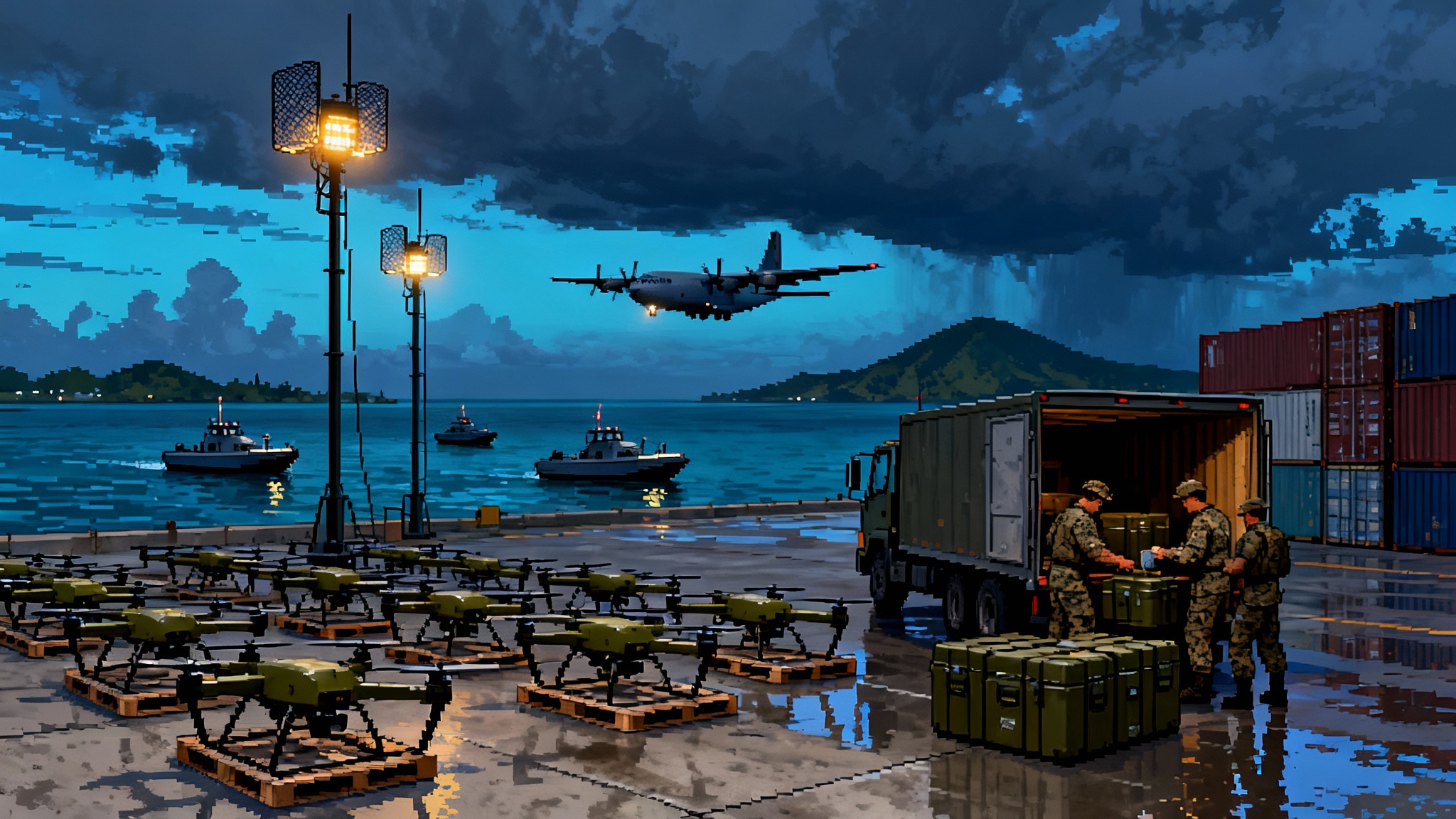Microwaves Go Mainline: High Power Counter-Drone Weapons Field
This summer turned high-power microwave from demo to duty. Live fire in the Indo-Pacific, a Marine expeditionary prototype, and the Army’s Generation II buy show software-defined HPM becoming the mass-defense layer against drone swarms.

Breaking through: a summer of proof that microwaves are moving to the line
On July 17, 2025, the U.S. Army awarded Epirus a follow-on contract to deliver two Generation II Indirect Fire Protection Capability high-power microwave systems, as detailed in the IFPC-HPM GEN II award announcement. The company says the new variant brings more range, more power, and higher lethality, a direct response to soldier feedback from a year of testing and early field use. It is a crisp signal that high-power microwave counter-drone weapons are no longer a laboratory curiosity but a program being iterated in the hands of operators.
That July headline anchored a season of real-world trials. In late April, during Exercise Balikatan in the Philippines, soldiers from the 1st Multi-Domain Task Force and air defenders from 1-51 Air Defense Artillery Regiment teamed with the Philippine Air Force and U.S. Marines to run a layered, non-kinetic defense against small unmanned aircraft systems. They paired the Army’s high-power microwave with the Fixed Site Low, Slow, Small Unmanned Aerial System Integrated Defeat System and demonstrated swarm defeat under tropical conditions, according to the Army Balikatan HPM live fire.
Two days after those drills, on April 29, the Marine Corps’ pathfinder prototype known as the Expeditionary Directed Energy Counter-Swarm system arrived at Naval Surface Warfare Center Dahlgren for Marine experimentation. And on April 17, the United Kingdom announced that British soldiers had taken down drone swarms with a radio frequency directed-energy demonstrator in West Wales, the largest British Army counter-swarm trial to date. Put together, these events show the same story from three angles: software-defined high-power microwave is leaving the slide deck and entering service-like use.
What is a high-power microwave weapon, in human terms
A high-power microwave weapon is an energy system that emits short, intense bursts of radio frequency power tuned to disrupt the electronics that keep a drone alive. If you have ever held a magnet near an old speaker and heard static distort the music, you have felt a tiny version of what is happening. A high-power microwave system turns that interference into a focused effect at tactically useful ranges. Instead of one magnet and a speaker, think of a stadium light array of gallium nitride amplifiers, timed by software so that their pulses arrive together on target like a coordinated drumline. The pulses induce currents in circuit boards and cables, which can cause processors to latch up, radios to drop, and power regulation to falter. The drone does not explode. It forgets how to fly.
The modern twist is that these systems are software defined. Operators and engineers can change pulse shape, length, repetition, and frequency sets with software loads rather than hardware rebuilds. That matters because the drone threat mutates. New flight controllers, different receiver bands, and novel autonomy stacks appear every month. A software-defined high-power microwave can be retuned to chase those changes, the way a smartphone receives a firmware update to stay compatible with new networks. This mirrors trends across defense programs, where the XM30 program goes software defined to accelerate capability updates.
The cost curve flips when one shot can down many
Drone swarms are cheap to launch and expensive to shoot down with missiles. If a unit faces a raid of twenty quadcopters and must use a short-range missile at six figures per round, the attacker has forced an unfavorable trade. A high-power microwave pulse costs fuel and maintenance, not a missile from a thin magazine. More importantly, it can create a one-to-many outcome. A single engagement can disrupt multiple aircraft flying within the beam, and follow-on pulses can sweep or bracket the volume. Lasers offer a precise one-to-one kill with a negligible cost per shot, which is valuable against isolated targets and is why lasers reset air defense math. High-power microwave fills the mass-defense role, handling many cheap drones fast so that interceptors and guns remain for the small fraction that break through.
The April events underline that shift in real units, not theory. In the Philippines, the Army ran a layered, non-kinetic architecture where sensing and tracking from the Fixed Site Low, Slow, Small Unmanned Aerial System Integrated Defeat System cued the high-power microwave for swarm effects. Marines brought their Marine Air Defense Integrated System to the same range, which is important because joint interoperability is the difference between a useful demonstration and a fieldable capability. In the United Kingdom, soldiers used a radio frequency directed-energy demonstrator to neutralize multiple drones quickly. In the United States, the Marine Corps received a portable, expeditionary prototype designed to bolt to a light trailer for the Low Altitude Air Defense mission.
Software is the secret sauce
Why did these systems arrive so quickly and move from first delivery to second generation in under two years? The answer is largely software. With a software-defined architecture, rapid updates can come in three forms:
- Waveform agility: change the pulse width, repetition, and frequency to exploit susceptibilities in new flight controllers. Think of it as changing the lockpick for a different lock, without re-machining the tool.
- Beam control: use digital beamforming to paint a controlled volume of airspace and then sweep it, or to notch out exclusion zones so friendly aircraft and sensors are not affected.
- System learning: feed post-mission telemetry and test data into models that suggest better engagement settings for future raids, then push those settings across the fleet overnight.
Just as importantly, software lets the microwave weapon speak fluently with command-and-control networks. The Army’s first acceptance testing validated interoperability with Forward Area Air Defense Command and Control. That connection allows a microwave platoon to receive tracks from a network of radars, hand over engagements, and get positive identification through electro-optic sensors that are bound into the same digital picture. The net result is not a lone truck zapping whatever flies nearby. It is a node in a joint kill chain that can be tasked, supervised, and recorded like any other effector.
How this went from one unit to a coalition story in 90 days
- April 17, 2025: The United Kingdom’s Ministry of Defence announces that British soldiers neutralized drone swarms with a radio frequency directed-energy demonstrator in West Wales. The trial is framed as the largest British Army counter-swarm exercise to date and confirms that allies see the same mass-drone problem and the same non-kinetic answer.
- April 29, 2025: The U.S. Navy’s Dahlgren division receives the Marine Corps’ Expeditionary Directed Energy Counter-Swarm prototype. The system is a derivative of the Leonidas Expeditionary design and is sized for the Marine Corps’ small trailers and light tactical vehicles, a fit for expeditionary advanced base operations.
- Late April to May 2, 2025: At Exercise Balikatan in Zambales, the Army integrates high-power microwave with the Fixed Site Low, Slow, Small Unmanned Aerial System Integrated Defeat System for a layered, non-kinetic defense and demonstrates swarm defeat in a hot, humid environment.
- July 17, 2025: The Army signs for Generation II high-power microwave systems for Indirect Fire Protection Capability, with explicit emphasis on more range and power plus usability improvements.
That is a cross-service, allied sequence in a single quarter. It shows that this is not a boutique solution owned by one niche office. It is a category moving toward common use, aligned with how cheap autonomy goes to scale.
What changes for commanders on the ground
- Magazine depth and tempo: a battery with high-power microwave can stay in the fight longer under saturation. The crew recharges and cools rather than rearming expensive missiles.
- Rules of engagement clarity: the ability to disable rather than detonate drones over dense terrain gives commanders more options when collateral damage is a concern.
- Layered effects: combine microwave for the bulk of the swarm, lasers for precise singles, and guns or missiles for leakers. The practical art is scheduling those effects so they do not interfere with each other.
- Training and safety: microwave is still an energy weapon with fratricide risk. Units will need checklists, range cards, and portable spectrum monitors to ensure that friendly radios, navigation sets, and aircraft stay outside the hazard volume during engagements.
The 2026 to 2028 scaling path
1. Power and form factors
- 2026: field Generation II Indirect Fire Protection Capability systems with extended range and improved lethality. Focus on heat management and duty cycle so crews can fire longer bursts and cycle faster in hot weather. Expect an expeditionary variant for Marines and Army light forces to get a second article for user evaluation with sealed enclosures and quick-connect power kits.
- 2027: introduce a compact, vehicle-integrated variant for maneuver short-range air defense units. Pair the microwave array with a stabilized mast and a smaller power module so it can ride on a common eight-wheel chassis. The goal is to keep pace tactically with armored formations without the need for a dedicated generator trailer.
- 2028: maritime and base-defense variants mature with shipboard hardening and electromagnetic compatibility testing complete. Expect a rack-mounted version for forward operating sites that plugs into existing shelters and can share power with radar vans.
2. Command and control integration
- 2026: standardize Forward Area Air Defense Command and Control messages for high-power microwave. Write playbooks that define when an engagement authority uses microwave first versus laser first, and how to record the event for battle damage assessment.
- 2027: bridge to the Integrated Battle Command System where required, so microwave units can be tasked by the same mission-command tools used by interceptors. The technical piece is message translation and time synchronization; the human piece is updating joint tactics so mixed batteries can share the same air picture without duplicate engagements.
- 2028: coalition data model. Align with allied command-and-control schemas so a British or Australian microwave unit can sit in a U.S. network during a combined exercise and receive tracks and permissions with minimal bespoke engineering.
3. Doctrine and training
- 2026: publish a counter-swarm annex to air defense doctrine that assigns roles by density of threat. Microwave for mass, laser for singles, interceptors for hard targets and leakers. Establish a safety appendix that sets standard exclusion arcs around friendly aircraft, satellites of opportunity, and civilian infrastructure.
- 2027: build a directed-energy lane into joint training centers. Units should face thirty to fifty small drones on a live range with a mixed battery of microwave, laser, and guns. The goal is to force real scheduling and deconfliction decisions.
- 2028: integrate microwave effects into maneuver rehearsals at division level. Air defenders should practice repositioning to protect logistics nodes and refuel points while brigade staff schedule microwave and cyber effects against hostile uncrewed systems before a breach or river crossing.
4. Allied uptake and industry capacity
- 2026: the United Kingdom and at least one Indo-Pacific partner select a demonstrator path aligned to their vehicle fleets. This keeps cost down and speeds integration with existing power and cooling kits.
- 2027: first foreign military sales case closes for a base-defense variant with a small number of systems for a high-priority airfield or port. The vendor base adds second sources for gallium nitride modules and high-voltage power supplies to reduce bottlenecks.
- 2028: a coalition standard emerges for data, safety signage, and joint fire-control messages. This is the moment microwave becomes interchangeable across allied formations.
The hard problems to solve next
- Electromagnetic fratricide: ensure that a microwave sweep does not blank a friendly radar or break data links for a manned aircraft. The answer will be precise beam control plus strict scheduling that deconflicts by azimuth and altitude block.
- Thermal management: duty cycle and heat will be the first limiter in hot climates. Expect liquid cooling loops, heat exchangers, and careful siting to pull air across the array without clogging filters.
- Legal and policy clarity: law of armed conflict and domestic safety rules must keep pace. Clear rules for testing near airfields, hard stop procedures, and automatic shutoff if a friendly aircraft enters the hazard volume will build trust with commanders and communities.
- Supply chain: gallium nitride devices and ruggedized power electronics are not as commoditized as bullets. Multi-year procurement and second-source qualification will smooth production.
Concrete moves to make in the next 12 months
- Program offices: lock in a software update rhythm. Quarterly software drops with test harnesses will keep pace with drone electronics. Push cyber hardening in parallel, because these systems are just as much software as hardware.
- Units receiving systems: build a microwave safety playbook. That means a range card showing hazard volumes, a laminated checklist for spectrum deconfliction, and a standard brief to pilots and unmanned aircraft operators before every live fire.
- Industry: publish interface control documents for power, cooling, and command and control. The more plug-and-play the system, the faster allies and other services can bolt it to their vehicles and networks.
- Allies: plan joint trials that stress coalition command and control. The Balikatan live fires showed the value of shared sensor and effector threads. Replicate that in Europe and the Middle East with mixed batteries so lessons move faster than the threat.
The bottom line
This year’s sequence of events reads like a product roadmap made visible in the field: a July contract for a second-generation Army system, April live fires in the Philippines with joint partners, a Marine expeditionary prototype on the ramp, and a British swarm-kill trial in Wales. The common thread is software-defined power. When the waveform is code and the beam is digitally steered, crews can adapt to new drones as fast as the threat adapts to them. That is how you flip the cost curve and keep the advantage when the sky fills with cheap airframes.
As the Army moves Generation II into units, the Marine Corps expands expeditionary trials, and allies lock in their own demonstrators, the task now is to scale without losing the focus that got the technology here. Treat high-power microwave as another effector in the network, not a unicorn. Keep the software moving, keep the training honest, and keep the interfaces open. Do that, and by 2028 microwave will not be a novelty in a news release. It will be another tool that commanders assume is on the line the moment the drones appear.






